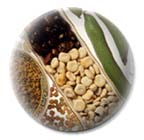- Home
- Introductions

|
Vegetable Seed Production:You are here: Seed Production: Brassicaceae : Cauliflower
Soil Nutrition Deep, loamy, well-drained soils are needed for the production of cauliflower.The soil pH and fertility should be carefully maintained as described for cabbage. Boron stress can cause stem cracking or browning of individual florets of broccoli and water-soaked areas in the stem and center of the branches of the curd in cauliflower. Both broccoli and cauliflower are also sensitive to Mo deficiency which is expressed as "whiptail" in which the leaf blades fail to expand. Nitrogen deficiency, the exposure of young cauliflower plants to low temperature or environmental stress, or the combination of both, can lead to buttoning in which the head or curd forms prematurely before the plant is fully developed. Cauliflower can develop "ricey" heads in which small white flower buds develop and the curd appears like boiled rice. This defect has been associated with specific cultivars, high temperatures during curd development, rapid plant growth, and heavy applications of N. Blindness or lack of curd formation may have several causes including poor fertility, insect damage, genetic irregularities or cold temperatures. Cauliflower is also sensitive to magnesium (Mg) and manganese (Mn) deficiencies, which are expressed as interveinal chlorosis on the older or younger leaves, respectively. Soil tests and the management of soil pH are critical in the production of cauliflower. Isolation Most authorities consider it important to have a greater recommended distance (up to 1500 m) between different types of B. oleracea, e.g. cabbages and cauliflowers, than between different cultivars of the same type, e.g. two cabbage cultivars (up to 1000 m). Some countries have introduced zoning schemes for some of the Brassica spp. Planting The preferred planting method will depend upon the crop to be grown, the growing region, and the target market. Most crops grown for seed or seed oil, forage, and cover crops are sown with a seed drill. In some areas, particularly the western United States, Arizona and Texas, cruciferous crops (cabbage, broccoli, cauliflower, greens, and many of the Asian vegetables) are direct-seeded using precision seeders. However, for early production of cabbage, cauliflower, and broccoli or in areas where plant establishment is a problem because of temperature and moisture stress, transplants may be used. Direct SeedingFor direct seeding, adequate soil preparation is essential. Seeding should occur when soil moisture and temperature conditions favor rapid germination to avoid poor stands. In crops where uniform maturity is critical for efficient harvesting, using graded seed may be beneficial for uniform germination and early plant vigor. The use of precision seeders can greatly improve plant spacing and reduce the need for hand thinning. TransplantsSeed beds for transplants should be irrigated to ensure adequate growth after germination. The soil on which seed beds are to be made must be friable, well drained, and free of noxious weeds. Soil pH should be in the range of 6.0 to 6.5, with soil fertility adequate for plant growth but not excessive. Seeding depth should be 1.5 to 3.0 cm (0.5-1.2 inches), depending upon available soil moisture and prevalent soil temperature. Seeding should be deeper in dry conditions or in soils that are prone to drying out. The optimum distance between seed is 1 to 2 cm (0.4-0.8 inches). One ounce of seed should provide approximately 3,000 transplants. Irrigation Adequate water management is needed to promote uniform crop maturity but excessive moisture or poor drainage may contribute to the development of black rot or Phytophthora stem rot. Several types of irrigation systems such as sprinkler, furrow, sub-surface, and trickle or drip are used on cruciferous crops. The general recommendation of at least one inch of water per week applies to this crop. For areas where irrigation water quality is a problem, such as the desert regions in the Western US, excess salts can be leached from the top of the soil bed to below the rooting zone of seedlings if sufficient water is applied. Keeping the soil surface wet will minimize upward movement of salt. Furrow irrigation may be cheaper in some areas but fields must be flat and well-graded to ensure that water moves uniformly through the soil. Irrigation scheduling should be dependent upon the amount of available water in the soil, moisture requirements of the crop which may change as the crop matures, and the current evapotranspiration rate (e.g. pan evaporation). Moisture stressed plants are frequently more susceptible to damage by nematodes, root diseases, insects, and less competitive with weeds. In many areas, the final irrigation is scheduled a few days to one week before the crop is harvested to ensure the plants are fully hydrated. Roguing
Seed Harvest All of the cole crops have a strong tendency to shattering of their seed
pods. It is therefore important that appropriate action is taken before
seeds are lost. Cleaning The seeds of Brassica spp. crack very easily and it is therefore
important that a relatively slow cylinder speed, not normally exceeding
700 rpm, is used although faster speeds may be required if the material
is not very brittle. Seed Yield The reported seed yields vary from one area to another and also depend on the type but the following figures are a guide: Cabbage yield 700 kg/ha (625 pounds per acre). Seed Identification:
|
||||||||||||||||||||